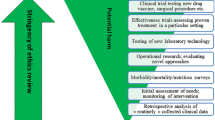Abstract
The paper presents an analysis of policy directives needed to respond to threats of harm (e.g., violence against third parties) that may arise in the course of conducting descriptive epidemiological research with high-risk populations. It identifies two key areas where new policies must be developed to guide researchers conducting such investigations. The paper recommends that: (1) an NIH consensus panel be convened to set standards, analogous to Common Toxicity Criteria (CTC) criteria, to classify the severity of different types of indirect, non-research-related risk; and (2) case-based training modules be developed and incorporated into public health research ethics courses and training programs, to enhance researcher judgments in determining the likelihood of harm in different situations. In addition, researchers, Institutional Review Boards (IRBs) and community advisory groups must consider the issue of staff safety and the effectiveness of available responses to reduce the threat of harm. The author reviews and discusses implications for informed consent and IRB review.
Similar content being viewed by others
References
Savulescu J, Spriggs M . The hexamethonium asthma study and the death of a normal volunteer in research. Journal of Medical Ethics. 2002;28:3–4.
Steinbrook R . Protecting research subjects – the crisis at Johns Hopkins. New England Journal of Medicine. 2002;346:716–720.
Resnik DB . Liability for institutional review boards. Journal of Legal Medicine. 2004;25:131–184.
Mello MM, Studdert DM, Brennan TA . The rise of litigation in human subjects research. Annals of Internal Medicine. 2003;139:40–45.
Childress JF, Faden RR, Gaare RD, Gostin LO, Kahn J, Bonnie RJ, et al. Public health ethics: Mapping the terrain. Journal of Law Medicine & Ethics. 2002;30:170–178.
Kass NE . An ethics framework for public health. American Journal of Public Health. 2001;91:1776–1782.
Maryland Court of Appeals. Ericka Grimes v Kennedy Krieger Institute, Inc.. 2001; No. 128, September Term, 2000 (366 Md. 29, 782 A 2d. 807, 2001). Available at: http://www.aau.edu/research/Paint9.17.01.pdf, accessed 2 June 2006.
Buchanan DR, Miller FG . Justice and fairness in the Kennedy Krieger Institute lead paint study: The ethics of public health research on less expensive, less effective interventions. American Journal of Public Health. 2006;96:781–787.
Gold EB . Confidentiality and privacy protection in epidemiological research. In: Coughlin S, Beauchamp T, editors. Ethics and Epidemiology. New York: Oxford University Press; 1996, p. 128–141.
Abrams N . Ethics and public policy in high-risk research. In: Tancredi L, editor. Ethical Issues in Epidemiological Research. New Brunswick NJ: Rutgers University Press; 1986, p. 47–63.
Gostin LO . Jacobson v Massachusetts at 100 years: Police power and civil liberties in tension. American Journal of Public Health. 2005;95:576–581.
Colgrove J, Bayer R . Manifold restraints: Liberty, public health, and the legacy of Jacobson v Massachusetts. American Journal of Public Health. 2005;95:571–576.
Macklin R . HIV-infected psychiatric patients: Beyond confidentiality. Ethics & Behavior. 1991;1:3–20.
Ferris LE, Barkun H, Carlisle J, Hoffman B, Katz C, Silverman M . Defining the physician's duty to warn: Consensus statement of Ontario's medical expert panel on duty to inform. Canadian Medical Association Journal. 1998;158:1473–1479.
Felthous AR . The clinician's duty to warn or protect. Behavioral Sciences & The Law. 2001;19:321–324.
Appelbaum PS, Rosenbaum A . Tarasoff and the researcher: Does the duty to protect apply in the research setting? American Psychologist. 1989;44:885–894.
Walcott DM, Cerundolo P, Beck JC . Current analysis of the Tarasoff duty: An evolution towards the limitation of the duty to protect. Behavioral Sciences & The Law. 2001;19:325–343.
Gutheil TG . Moral justification for Tarasoff-type warnings and breach of confidentiality: A clinician's perspective. Behavioral Sciences & The Law. 2001;19:345–353.
Huprich SK, Fuller KM, Schneider RB . Divergent ethical perspectives on the duty-to-warn principle with HIV patients. Ethics & Behavior. 2003;13:263–278.
Kass NE, Gielen AC . The ethics of contact tracing programs and their implications for women. Duke Journal of Gender Law & Policy. 1998;5:89–102.
Kagle JD, Kopels S . Confidentiality after Tarasoff. Health & Social Work. 1994;19:217–222.
Beck JC . Legal and ethical duties of the clinician treating a patient who is liable to be impulsively violent. Behavioral Sciences & The Law. 1998;16:375–389.
Richardson HS, Belsky L . The ancillary-care responsibilities of medical researchers: An ethical framework for thinking about the clinical care that researchers owe their subjects. Hastings Center Report. 2004;34:25–33.
Beauchamp TL, Childress JF . Principles of Biomedical Ethics. 5th edition, New York: Oxford University Press; 2001, p. 80–88.
Emanuel EJ, Wendler D, Grady C . What makes clinical research ethical? Journal of American Medical Association. 2000;283:2701–2711.
Taylor C . Critical Notice. Canadian Journal of Philosophy. 1988;18:805–814.
Taylor C . Explanation and practical reason. In: Taylor C, editor. Philosophical Arguments. Cambridge: Harvard University Press; 1995, p. 34–60.
Jonsen AR, Toulmin S . The Abuse of Casuistry: A History of Moral Reasoning. Berekely: University of California Press; 1988.
Acknowledgements
The author thanks Dr. Franklin G Miller of the NIH Department of Clinical Bioethics for his helpful comments on earlier drafts of this paper.
Author information
Authors and Affiliations
Corresponding author
Additional information
This paper identifies areas in need of policy development in the United States to guide researchers conducting epidemiological investigations with high risk populations. Researchers' responsibilities for responding to threats of harm in this domain have been overlooked although risks of harm in clinical experiments involving human subjects have received extensive attention.
Rights and permissions
About this article
Cite this article
Buchanan, D. Policy Needs Regarding the Duty to Protect in Epidemiological Research with High-Risk Populations. J Public Health Pol 27, 293–308 (2006). https://doi.org/10.1057/palgrave.jphp.3200084
Published:
Issue Date:
DOI: https://doi.org/10.1057/palgrave.jphp.3200084




